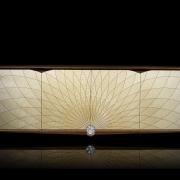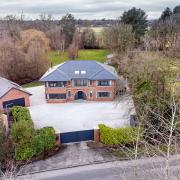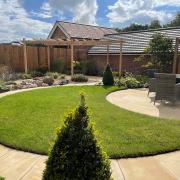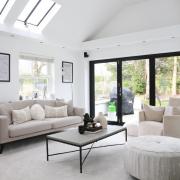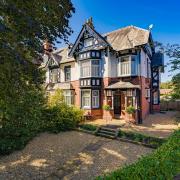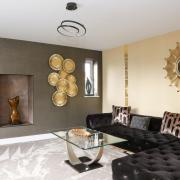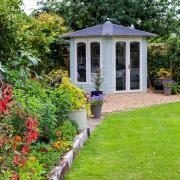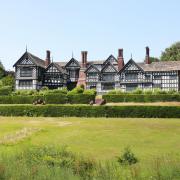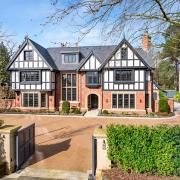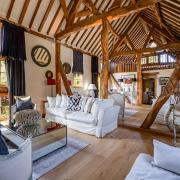The black and white timbered medieval residence with a fascinating history, Haslington Hall, is for sale. Could it be your next project?
After a devastating fire Haslington Hall was saved by retired property developer Peter Jans, who tells Kate Houghton why this intriguing and important piece of Cheshire architecture needs and deserves a new custodian.
When I bought Haslington Hall in 2019 it was basically derelict and in a very parlous state. Badly damaged by fire and having been abandoned for some time it had been regularly raided by thieves stripping away all the copper and lead. I bought it to turn back into a family home, for my wife and children. It’s now no longer derelict: when it rains outside it no longer rains on the inside and it will be really a great project for someone. Since putting it on the market I have had so much interest, with viewings daily, but I am going to be choosy who I sell it to – Haslington Hall has to be preserved.

I quickly became fascinated with the long history of this beautiful building. What must it have seen over the centuries of its existence? Discovering that history proved to be something of a challenge, however. It is difficult to trace the early history of the hall, as all the early documents relating to the building were kept in a bank vault in Manchester, which was destroyed in 1940, during a Luftwaffe bombing raid.
I have however found several documents that confirm Haslington Hall was built around 1220, in the area which is now Mere Street/Waterloo Road. It was constructed as a large quadrangle building, with an inner courtyard and a moat, in the style of the more famous Speke Hall. It was built by Ralph the Auld, who reputedly lived to the ripe old age of 150. This was in the reign of King Edward II, and only shortly after the first Magna Carta was signed.
The village of Haslington grew around the original hall. The earliest mention I have been able to find of the Village of Haslington is 1256, some 36 years after the hall was built.
A licence exists, dated 1329, naming Sir Ralph Vernon and the manor of Haslington. It also mentions his son, Master Ralph. Ralph may have been a family name and the original Ralph the Auld, known as the 'long liver’ may have been Sir Ralph’s father, hence the 150-year life span; it was three Ralphs long. This document was sold at auction in 2018.

By some accounts, the area where the hall was situated became waterlogged and the building dilapidated, and it was consequently decided to deconstruct and move it to its present position, in around 1480. The building was taken apart – a fairly easy job with a timber frame: remove the pegs and take it apart, move it a piece at a time and rebuild it, using only the best timbers. Records show, however, that the part moved to its present position was the north face only, which forms part of the current hall. Fascinatingly, it can be seen that the building has been taken apart and reconstructed, as the carpenter’s marks don’t always tally on adjoining timbers.
The first iteration of nearby St Matthew’s Church dates back to around 1480, when Haslington Hall was moved to its present position. It was then known as Haslington Chapel. The church was built from leftover timbers from the original hall and was a black and white timber-framed structure. This in turn fell into disrepair and a new brick-built church was built in 1810. This building was either added to or restructured in 1910. The Architects magazine of the day had a fairly uncomplimentary article about the new church, but it does mention it retained one redeeming feature, a 16th-century window from Haslington Hall. It is still my intention to don the balaclava and reclaim my window on some wild and windy night...

After its move to its present position the hall was extended, firstly with the brick-built left hand gabled side (believed 1500s) and later with the right-hand gable,reputedly built from the timber of ships from the Spanish Armada of 1588, many of which were wrecked on the coasts of Scotland and Ireland. There is some strength to this assertion, as Admiral Sir Francis Vernon, who rebuilt the hall in 1545, sailed with Sir Francis Drake against the Armada, and would certainly have been in a good position to claim some spoils.
During the Civil War, Haslington (and nearby Crewe) were ruthlessly pillaged by marauding Royalist troops, who did not shower themselves in glory, conducting a massacre of residents seeking safety in a church in a nearby village. It is rumoured that Oliver Cromwell himself visited the Haslington Hall – but whether that is true, or if he came as friend or foe, we do not know.

The Vernon family retained ownership until 1799, when it was sold to the Broughton family, and lived in for 110 years before the estate was sold to then owner Sir Delves Broughton, in 1911. The purchaser was Cheshire Council and it retained ownership for eight years until it sold in 1919 to Colonel Humphrey Watts. This gentleman came from wealth and heritage – his grandfather was Sir James Watts, Mayor of Manchester (1855–1857), High Sheriff of Lancashire and owner of Abney Hall in Cheadle. He was the owner of S & J Watts Limited, who built the Watts Warehouse on Portland Street and an important figure among British industrialists; so important in face that Prince Albert chose to stay with him when he visited Manchester to open the Art Treasures Exhibition in 1857.
I am reading an autobiography of Dame Felicity Peake, daughter of Humphrey Watts. She describes her childhood at the hall from 1919, with the panelled rooms, hallways and priest hole and says she and her sister kept pet rabbits on the second floor. Dame Felicity was the first director of the Women's Royal Air Force (WRAF).
Eleanor Watts, Humphrey Watts’ other daughter was a close friend of Evelyn Waugh, who visited the hall on many occasions, and reportedly claimed he was going to commit suicide behind the rhododendrons. Thankfully, he changed his mind. Agatha Christie was Felicity Peake’s aunt and she also visited. Some articles claim the author was here when she disappeared in 1929 for 11 days. She was found in Harrogate, but where was she in the intervening days? Only the family knows, but it is a nice thought.
In around 1956 the hall was bought by the Hill family. It was then sold in 1972 to Anthony and Jane Vernon. In 2005 it was acquired by Mohammed Isaq who ran it as a commercial wedding venue. Sadly, during Mr Isaq’s tenure, a fire broke out which damaged the structure.
In 2019 I was lucky enough to buy the estate and we have spent the last three years clearing the debris and rubbish – more than 500 tons so far. It has been a labour of love, blood, sweat and, occasionally, tears.
Now I have made the hard decision to put the hall up for sale, as there is some 16,000 sq. ft of living space and there are only two of us here – my wife Sally and me – our children having moved on and out, and sometimes we have trouble locating each other. It’s been rather magnificent living here, but it’s time to pass the hall to someone who can complete what we have started.
Despite its great age, it has a wonderful, homely feel, perhaps an echo of the many happy times had by the families who lived here from the 13th century onwards. There are certainly many more happy memories to be made here. And I have no plans to move far away. My life has to date been very peripatetic. I have moved countries five times, moving back to the UK in 2010, and have been looking for a place to call home ever since. The move from London to Cheshire gave me that feeling of home; my family and I lived here in 2019, I didn’t buy Haslington Hall to develop it, but to save it, and I think this is what we, as a family, have done.
Haslington Hall,close to the village of Haslington, between Crewe and Alsager, is for sale through Savills, for £800,000, savills.com
Savills say...
A stunning Grade I listed medieval hall with fabulous grounds of around nine acres with lake, stables and tack room. This fabulous hall offers the opportunity to create a spectacular home.
This hall is magical, it is in need of full renovation but offers huge potential to create a stunning family home or multiple dwellings (subject to planning). The hall comes with around nine acres, two ponds, a Victorian stable block, and staff quarters.

This unique building, in brief, comprises of: ground floor with high ceilings; fabulous entrance door opening to a lobby with flagstone entrance hall, two staircases and a third that could be re-instated, kitchen with a large inglenook fireplace with fitted triple oil-fired Aga, by-kitchen with sinks and fire place, entrance reception hallway separating the main hall from the spacious staff quarters; conservatory with gun cupboard, safe room and fireplace, dining room and drawing room each with fireplace, hallway with second large entrance door to front and one to the rear, Armada room with fireplace. The first floor is equally well proportioned, with high ceilings: bedroom suite one with fireplace, dual bathrooms and a large dressing room with lobby outside also with fireplace, bedroom two with fireplace, bedroom three with en suite, bedroom four with en suite and fireplace, bedroom five with bay windows and fireplace and the Armada bedroom, with fireplace and large bathroom.




